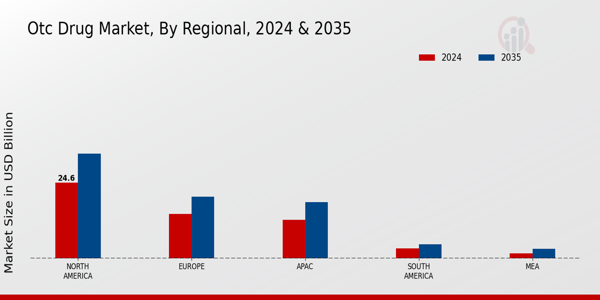Rising Healthcare Costs
Escalating healthcare costs are significantly influencing the OTC Drugs Market. As individuals seek to manage their health without incurring high medical expenses, there is a marked shift towards self-medication. The financial burden associated with prescription medications and healthcare services has prompted consumers to explore OTC options as a cost-effective alternative. Reports indicate that the global healthcare expenditure is projected to reach approximately 10 trillion USD by 2025, which may further drive the demand for OTC products. This trend suggests that consumers are increasingly inclined to utilize OTC drugs for minor health issues, thereby propelling the growth of The Global OTC Drugs Industry.
Growing Aging Population
The increasing aging population is a pivotal driver for the OTC Drugs Market. As individuals age, they often experience a higher prevalence of chronic conditions, leading to a greater demand for over-the-counter medications. In many regions, the demographic shift towards an older population is notable, with projections indicating that by 2030, nearly 1 in 6 people will be aged 60 years or older. This demographic trend is likely to enhance the market for OTC drugs, as older adults tend to prefer self-medication for managing minor ailments. Consequently, The Global OTC Drugs Industry is expected to witness substantial growth, driven by the need for accessible and effective healthcare solutions tailored to this demographic.
Expansion of Retail Channels
The expansion of retail channels is a significant factor propelling the OTC Drugs Market. The proliferation of pharmacies, supermarkets, and online platforms has made OTC products more accessible to consumers. E-commerce, in particular, has transformed the way consumers purchase OTC medications, providing convenience and a wider selection of products. Data suggests that online sales of OTC drugs are expected to grow at a compound annual growth rate of over 10% in the coming years. This shift towards diverse retail channels is likely to enhance the visibility and availability of OTC products, thereby driving growth in The Global OTC Drugs Industry.
Increased Consumer Awareness and Education
The rise in consumer awareness and education regarding health and wellness is a crucial driver for the OTC Drugs Market. As individuals become more informed about health issues and treatment options, they are more likely to seek out OTC medications for self-treatment. Educational campaigns and accessible information through various media platforms have empowered consumers to make informed decisions about their health. This trend is reflected in the growing sales of OTC products, which have seen a steady increase in recent years. The Global OTC Drugs Industry is poised to benefit from this heightened awareness, as consumers increasingly recognize the value of OTC drugs in managing their health.
Technological Advancements in Drug Development
Technological advancements in drug development are reshaping the OTC Drugs Market. Innovations in formulation technologies and delivery systems have led to the creation of more effective and user-friendly OTC products. For instance, the development of transdermal patches and fast-dissolving tablets has enhanced the convenience and efficacy of self-medication. Furthermore, the integration of digital health technologies, such as mobile health applications, is facilitating better consumer engagement and education regarding OTC products. This evolution in drug development is likely to attract a broader consumer base, thereby contributing to the expansion of The Global OTC Drugs Industry.


















Leave a Comment